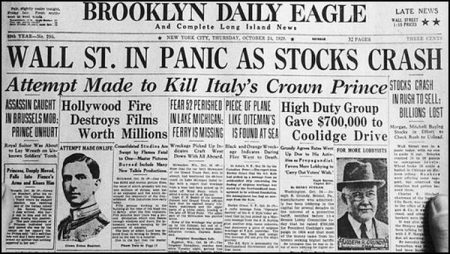In the autumn of 1929 came the catastrophe which so few had anticipated but which in retrospect seems inevitable–prices broke on the New York Stock Exchange, dragging down with them in their fall, first the economy of the United States itself, subsequently that of Europe and the rest of the world. Financial losses of such magnitude had never before been known in the history of capitalist society, and the ensuing depression was also unprecedented in scope.
There had always been business crises; economists had come to take them as normal and even to chart a certain regularity in their occurrence. But this one dwarfed all its predecessors: no previous depression had remotely approached it in length, in depth, and in the universality of impact. Small wonder that countless people were led to speculate whether the final collapse of capitalism itself, so long predicted by the Marxists, was not at last in sight.
On October 24, “Black Thursday,” nearly thirteen million dollars worth of stocks were sold in panic, and in the next three weeks the general industrial index of the New York Stock Exchange fell by more than half. Nevertheless, it was by no means clear at first, how severe the depression was going to be. Previous crises had originated in the United States–this was not the great novelty.
What was unprecedented was the extent of European economic dependence on America which the crash of 1929 revealed. This dependence varied greatly from country to country. Central Europe was involved first, as American financiers began to call in their short-term loans in Germany and Austria. Throughout 1930 these withdrawals of capital continued, until in May, 1931, the Austrian Creditanstalt suspended payments entirely. Thereafter, panic swept the Central European exchanges as bank after bank closed down and one industry after another began to reduce production and lay off workers.
Meantime the crisis had reached Great Britain. In September, 1931, the country went off the gold standard, to be followed two years later by the United States and nearly all the other financial powers of the world. The great exception was France: with a balanced economy and relative selfsufficiency, the French held off the crisis longer than anyone else–not until 1932 did its effects become really severe. But late involvement did not help the country in the long run: for France was the slowest and the least successful of the major powers in pulling itself out of the Depression, which left a wound in French society that was far from healed when the Second World War broke out.
The fall in production and the fall in prices everywhere reached unprecedented depths. In Germany–which was hit worst of all–production had fallen by 39 per cent, at the bottom of the Depression in 1932, and prices by only slightly less. In France, which was stubbornly holding to the gold standard, the price level in 1935 was just over half what it had been in 1930. But of all the manifestations of the Depression, unemployment was most grievous and most clearly left its mark on the whole era.
In this respect, France was the least seriously affected: the number of those out of work never rose above 850,000. But here as in Italy and in the agricultural nations in general, there was much semiemployment and concealed unemployment in the countryside. In Britain, the jobless numbered nearly three million–between a fifth and a quarter of the whole labor force. And in Germany unemployment mounted to the horrifying total of six million; trade-union executives estimated that more than two-fifths of their members were out of work entirely and another fifth employed only part time. With roughly half the population in desperation and want, it was no wonder that the Germans turned to the extremist leadership that they had so narrowly avoided in the crisis of 1923.
Elsewhere social unrest never reached such grave proportions, but throughout Europe governments and peoples felt themselves on the edge of a precipice, as the turbulent and questioning mood of the immediate postwar years returned with redoubled intensity. As had occurred during the war, a crisis situation evoked state intervention in the economy on a massive scale. Governments found themselves forced to resort to all sorts of measures of which the conservative disapproved.
These measure gradually came to follow a common pattern: most countries turned inward, trying to save their own economies without reference to, or regards for, their neighbors, through raising tariffs and setting up schemes for currency pooling and block buying abroad; they sought to relieve the sufferings of the unemployed through extended subsistence payments, on the model of the British dole, and to provide new jobs through vast programs of public works and, eventually, through rearmament.
Most of these measures were mere palliatives, however, undertaken in skeptical and hesitant fashion, and only after years of delay had robbed them of maximum effect. Furthermore, a number of them were of doubtful merit. The turn toward economic nationalism probably did as much harm as good–constricting the volume of world trade and still further reducing Europe’s share in it. In Europe, as in the United States, the only policy that brought much lasting benefit was direct provision of new employment by the government. Even this was far less effective in its original form of public works than in its subsequent guise of war production.
On both sides of the Atlantic, only rearmament proved a sufficiently powerful antidote to the Great Depression. It is sobering to note that the great power which was the most successful in pulling itself out of the slump–Nazi Germany–was also the one which plunged most whole-heartedly into preparation for war. Thus, by the mid- 1930’s, the economic and social struggles of the decade were blending imperceptibly into the origins of the Second World War itself.
Related Link: View more Popular Culture stories
Visits: 248



